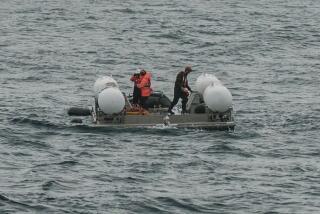Sub’s Sonar Failed to Detect Doomed Tug, Inquiry Finds
- Share via
Electronic detection equipment apparently failed to tell the crew of the nuclear-powered Navy submarine Houston that it was near the tugboat it accidentally dragged under last week with the loss of one tug sailor, a federal investigator said Wednesday.
National Transportation Safety Board investigator Donald J. Tyrrell said he believes that the Houston’s crew acted as quickly as it could to help after the 360-foot sub snagged a cable between the tugboat Barcona and two barges south of Long Beach early on June 14.
The tug was hauled down in 2,500 feet of water. Two of its crew survived by swimming to one of the barges, but pilot Bryan Ballanger, 32, of Norwalk, died.
“There was no undue delay on the part of the Navy,” Tyrrell said at a press conference in Long Beach. “I do not believe they could have communicated any faster than they did.”
Although there had been criticism over the length of time it took for the Houston to radio the Coast Guard that there had been an accident, Tyrrell pointed out that once the sub watch officer realized there was an emergency and ordered a fast dive, 30 or 40 minutes were needed to pump ballasts and make other preparations for resurfacing.
Tyrrell stressed that the safety board does not attempt to fix blame or liability but simply seeks to determine probable cause.
Second Accident
He said he did not investigate a second mishap that occurred Friday night when the same submarine cut through the gill net of a San Pedro fishing boat six miles south of Point Fermin. Tyrrell said he determined after a brief look that the net incident was not related to the tugboat accident.
As for the tug, Tyrrell said the submarine was ascending about 4:30 a.m. from a depth of 150 feet to periscope depth in order to get a navigation fix from a satellite scheduled to pass overhead.
The sonar equipment, Tyrrell said, was in “passive” operation, which allows crewmen to detect other vessels by engine noises. “Active” sonar, he said, emits “pings” that enable an enemy to pinpoint the position of the sub.
As the Houston went through its elaborate surfacing preparation and began to rise toward periscope depth, Tyrrell said, the “passive” sonar had indicated three contacts--the closest 8,000 yards away.
When the periscope broke the surface, Tyrrell said, the watch officer began making 360-degree sweeps, and on the second one sighted a red light that he took to be a fishing boat going away from the Houston.
The crewman manning the sonar equipment also concluded the other vessel was going away from the submarine, Tyrrell said. The officer was not able to see the lights on the tug indicating that it was towing. Nor did the officer see the barges.
Suddenly, however, the officer “saw a large black shape that filled the periscope,” Tyrrell said.
“The man told me he had never seen anything that close in his periscope before,” he added.
An emergency dive was ordered. The crew heard something strike the sail--or superstructure--and the Houston went down to about 300 feet. As it turned out, it was dragging the tugboat down with it.
When Cmdr. John Sohl III finally decided his submarine was clear of whatever it had snagged, the Houston went through another half hour of buoyancy preparation and surfaced.
As soon as it could, Tyrrell said, the sub captain notified the Coast Guard that there had been some sort of accident. A pleasure boat picked up the survivors from the tug.
Tyrrell said the sonar picked up the tug--but “not until they were very, very close to it.” Asked if the accident could have been averted with sonar in the active mode, he would say only, “Maybe.”
He said there are several possible explanations for the failure of the sonar to alert the sub. For instance, he said, a submarine can pick up a passive sonar contact either directly or after the signal bounces off the ocean floor. Conceivably, he said, the Houston was in the dead spot between the downward signal and the bounce-back in the minutes before the accident.
More to Read
Sign up for Essential California
The most important California stories and recommendations in your inbox every morning.
You may occasionally receive promotional content from the Los Angeles Times.













